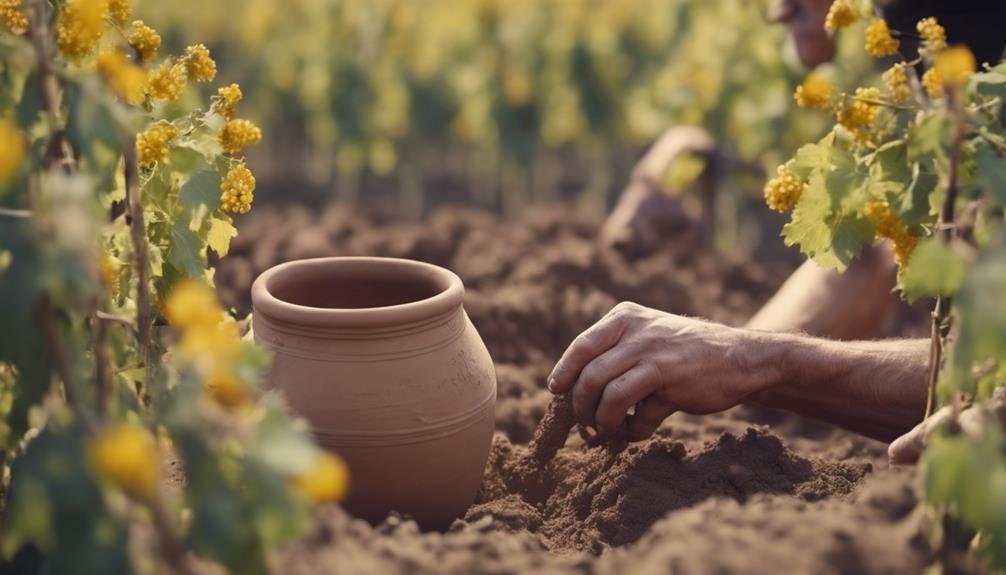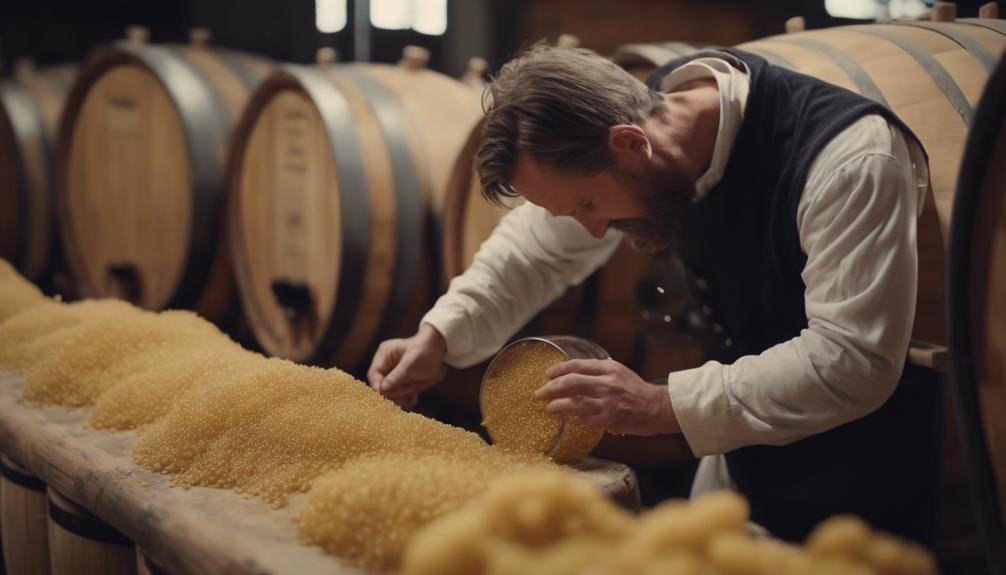Wild yeasts are reshaping wine fermentation by boosting flavors, showcasing terroir intricacies, and enriching wine sensory experiences. Their use adds complexity, aromatic diversity, and unique tastes to wines, appealing to those seeking distinctive notes. Wild fermentation underscores winemakers' creativity, environmental consciousness, and vineyard biodiversity, moving away from relying solely on commercial yeast strains. By leveraging historical techniques, wild yeasts spotlight terroir and natural processes, resulting in wines that authentically capture the essence of the land. To enhance predictability, vineyard management and fermentation monitoring are essential. Embrace the wild yeasts for a deeper understanding of wine's potential.
Impact of Wild Yeasts on Flavors
The utilization of wild yeasts in wine fermentation greatly influences the flavors of the final product, imparting distinct and unique characteristics that reflect the vineyard's terroir and the grape variety.
Wild yeast fermentation enhances flavor complexity by introducing a broader spectrum of aromatic diversity to the wine. This process can result in wines with a richer and more nuanced taste profile, showcasing a myriad of aromas that are not typically found in wines produced with commercial yeasts.
The diverse array of flavors derived from wild fermentation adds depth and interest to the wine, making it a preferred choice for those seeking wines with unique and complex tasting notes.
Winemakers who embrace wild fermentation are able to create wines that truly stand out regarding flavor complexity and aromatic diversity.
Benefits of Wild Fermentation
Utilizing wild yeasts in wine fermentation not only enhances the complexity and diversity of flavors but also offers numerous benefits that set wild-fermented wines apart in the domain of winemaking. Wild fermentation presents a unique opportunity for winemakers to showcase their creativity and respect for the environment. By harnessing the natural yeasts present in the vineyard, winemakers can create wines that truly reflect the terroir, leading to a more sustainable approach to winemaking. This method reduces the reliance on commercial yeast strains, promoting biodiversity in vineyards. Additionally, wild fermentation allows for the expression of a wide range of flavors and aromas that are not typically achievable with cultured yeasts.
| Benefits of Wild Fermentation | |||
|---|---|---|---|
| 1. Environmental Impact | 2. Winemaker Creativity | 3. Biodiversity Promotion | 4. Unique Flavor Profiles |
Historical Significance of Wild Yeasts

Harnessing the untamed power of wild yeasts in wine fermentation reveals a historical narrative rich in tradition and innovation.
Historical Significance of Wild Yeasts:
- Louis Pasteur's Discovery:
Louis Pasteur's 1859 experiment highlighted the ubiquity of microbes, shaping the understanding of fermentation in winemaking.
- Traditional Winemaking Techniques:
Indigenous yeasts have been an integral part of traditional winemaking techniques for centuries, contributing to the unique flavors and characteristics of wines.
- Evolution of Fermentation Practices:
While cultured yeasts are now commonly used, the resurgence of wild fermentation signifies a return to the roots of winemaking, showcasing the terroir of vineyards and emphasizing the importance of natural processes in creating distinctive wines.
Unique Characteristics of Wild Wines
Exploring the distinct attributes of wild wines offers a fascinating glimpse into the diverse spectrum of flavors and aromas derived from natural fermentation processes. Wild wines exhibit a unique terroir expression, reflecting the specific characteristics of the vineyard where the grapes were grown. This terroir expression enhances the sensory experience, providing wine enthusiasts with an authentic taste of the region.
The microbial diversity present in wild fermentation contributes to the complexity and depth of the final product. Each vineyard's microbial fingerprint influences the fermentation process, resulting in wines with a rich tapestry of flavors. Wild wines offer a sensory journey that captures the essence of the land, showcasing the intricate relationship between nature, grape, and yeast.
Overcoming Challenges in Wild Fermentation

When exploring the domain of wild wine fermentation, addressing the complexities and obstacles inherent in this natural process becomes pivotal. Challenges in wild fermentation can be overcome through the following strategies:
- Improving Consistency
- Implementing rigorous vineyard management practices to create a stable environment for wild yeast fermentation.
- Regular monitoring and adjusting of fermentation conditions to guarantee uniformity in the final product.
- Utilizing advanced techniques to enhance the predictability and repeatability of wild fermentation outcomes.
- Managing Expectations
- Educating consumers about the inherent variability in wild fermentation and its impact on wine characteristics.
- Setting clear expectations regarding the unique flavors and aromas that wild yeasts can introduce.
- Providing guidance on appreciating the diversity and complexity of wild fermented wines despite potential variations.
Frequently Asked Questions
How Do Vineyard Management Practices Impact the Quality of Wild Yeast in Fermentation?
Vineyard management practices greatly influence the quality of wild yeast in fermentation. Factors like soil composition, climate, grape varieties, and terroir impact microbial diversity. Understanding these elements aids winemakers in fostering ideal conditions for wild yeast fermentation.
What Are the Potential Effects of Vineyard Chemicals on Wild Yeast Ecosystems?
Vineyard chemicals may disrupt soil microbiome biodiversity, affecting wild yeast ecosystems important for fermentation success. Their influence can lead to unbalanced microflora, jeopardizing wine quality. Understanding and managing these impacts are essential in preserving natural fermentation processes in winemaking.
How Do Winemakers Adjust Vineyard Management for Wild Fermentation?
To guarantee successful wild fermentation, winemakers adapt vineyard practices to suit the impact of climate and soil composition. Adjustments in canopy management, irrigation, and nutrient levels are essential. Monitoring these factors optimizes conditions for native yeast proliferation and fermentation success.
What Role Does Consumer Acceptance Play in the Challenges of Wild Fermentation?
Consumer acceptance is pivotal in the challenges of wild fermentation. Understanding consumer preferences and market trends is essential for winemakers. The unique characteristics of wild-fermented wines, impacted by vintage variations, can either entice or deter consumers seeking consistency.
How Does Vintage Variation Impact Consistency in Wild Fermentation?
Vintage variation in wild fermentation impacts consistency due to climate influence on microbial diversity. Fluctuations in weather alter yeast populations, affecting fermentation outcomes. While celebrating terroir, winemakers must navigate the challenge of maintaining consistency amidst nature's whims.
Conclusion
To sum up,
the utilization of wild yeasts in wine fermentation processes has revolutionized the industry,
offering a unique and authentic experience for wine enthusiasts.
One notable example is
the success of a small boutique winery in Spain that exclusively uses wild fermentation techniques,
resulting in award-winning wines that capture the essence of the region's terroir.
This highlights the potential for wild fermentation to elevate the quality and complexity of wines,
showcasing the true artistry of winemaking.